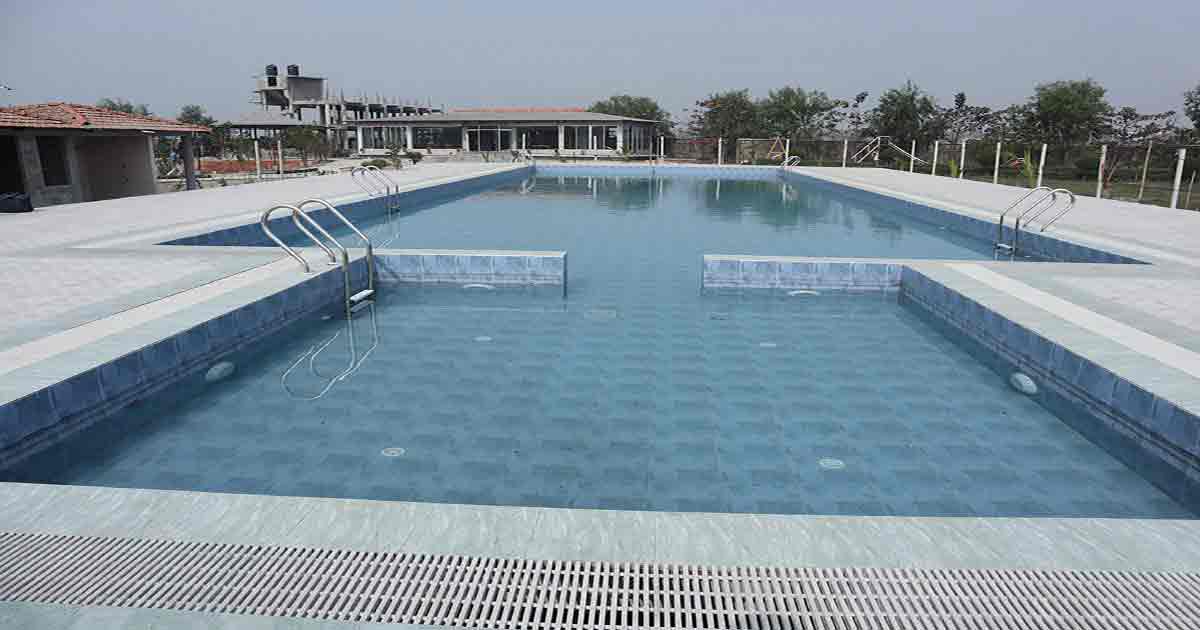Blue swimming pool tiles
Blue swimming pool tiles play a crucial role in the aesthetics, functionality, and overall appeal of swimming pools. In this comprehensive description, we will explore the various aspects of blue swimming pool tiles, including their types, materials, designs, installation methods, maintenance, and the overall impact they have on pool environments.
Importance of Swimming Pool Tiles
Tiles are an integral part of swimming pool construction and design. They not only enhance the visual appeal but also contribute to the pool’s durability, hygiene, and safety. Blue tiles, in particular, are popular for their soothing and refreshing aesthetic qualities, evoking images of clear skies or serene ocean waters. They come in a variety of shades, patterns, and textures, allowing pool designers and owners to create unique and inviting aquatic spaces.
Types of Blue Swimming Pool Tiles
Blue swimming pool tiles are available in several types based on materials and construction methods:
- Ceramic Tiles: Ceramic tiles are a classic choice for swimming pools due to their durability, versatility, and affordability. They are manufactured by firing clay and other minerals at high temperatures, resulting in a hard and dense surface that resists water absorption and chemical damage. Ceramic tiles are available in various shades of blue, ranging from light sky blue to deep navy, and can feature glossy or matte finishes.
- Glass Tiles: Glass tiles offer a luxurious and vibrant option for swimming pools. They are made from molten glass that is poured into molds and then hardened through a heating process. Glass tiles are prized for their luminous appearance, reflective qualities, and ability to create a shimmering effect underwater. Blue glass tiles can range from translucent to opaque, providing versatility in design and light reflection.
- Porcelain Tiles: Porcelain tiles are known for their strength, low porosity, and resistance to stains and scratches. They are made from dense clay fired at extremely high temperatures, resulting in a dense and durable tile surface. Blue porcelain tiles for swimming pools offer a robust option that withstands frequent use, harsh weather conditions, and chemical exposure.
- Mosaic Tiles: Mosaic tiles are small, typically square-shaped tiles that are mounted on mesh sheets for easy installation. They are available in ceramic, glass, or porcelain materials and offer intricate designs and patterns. Blue mosaic tiles allow for creative designs, including geometric patterns, waves, sea creatures, and abstract motifs, adding artistic flair to pool interiors and exteriors.
Design and Aesthetic Considerations
Blue swimming pool tiles contribute significantly to the overall design and ambiance of a pool area. Some design considerations include:
- Shade and Hue: Different shades of blue evoke different moods and visual effects. Lighter shades create a sense of spaciousness and tranquility, while darker shades add depth and drama to the pool environment.
- Texture and Finish: Tiles can have a glossy, matte, or textured finish. Glossy tiles reflect light and create a sparkling effect on the water’s surface, enhancing the pool’s visual appeal. Matte or textured tiles provide a more subdued and slip-resistant surface.
- Pattern and Layout: Tiles can be laid in various patterns, such as straight, diagonal, herringbone, or mosaic designs. The layout of tiles can emphasize certain features of the pool, such as steps, waterline, or decorative accents.
Installation Methods
Installing blue swimming pool tiles requires careful planning and execution to ensure durability and aesthetic integrity:
- Surface Preparation: The pool shell must be clean, level, and structurally sound before tile installation. Any existing tiles or finishes should be removed, and the surface should be thoroughly cleaned and dried.
- Adhesive Application: Tiles are typically adhered to the pool surface using a specialized adhesive or thin-set mortar. The adhesive is applied evenly to the back of each tile, ensuring complete coverage for a strong bond.
- Grouting: Once the tiles are set in place, grout is applied between the tiles to fill gaps and create a uniform, watertight seal. Epoxy grout is often recommended for swimming pools due to its waterproof properties and resistance to chemicals.
- Finishing Touches: After grouting, excess grout is cleaned off the tile surfaces, and the tiles are polished to achieve a smooth and uniform appearance. Sealants may be applied to protect the tiles and grout from stains, moisture, and fading.
Maintenance and Care
Proper maintenance is essential to preserve the beauty and functionality of blue swimming pool tiles:
- Regular Cleaning: Tiles should be cleaned regularly using a mild detergent and a non-abrasive sponge or cloth to remove dirt, oils, and debris. Avoid abrasive cleaners or tools that could scratch the tile surface.
- Water Chemistry: Maintain proper water chemistry to prevent mineral deposits and algae growth, which can stain or discolor tiles over time. Monitor pH, chlorine levels, and alkalinity according to manufacturer recommendations.
- Tile Inspection: Periodically inspect tiles for cracks, chips, or loose grout. Repair or replace damaged tiles promptly to prevent water infiltration and further damage.
- Sealing: Depending on the type of tile and grout used, consider applying a sealant periodically to protect against water penetration and maintain color vibrancy.
Environmental and Safety Considerations
- Slip Resistance: Choose tiles with textured surfaces or matte finishes to enhance slip resistance, especially in areas prone to wet conditions.
- UV Resistance: Ensure that tiles are UV-resistant to withstand prolonged exposure to sunlight without fading or discoloration.
- Recyclability: Opt for tiles made from recycled materials or eco-friendly manufacturing processes to minimize environmental impact.
Blue swimming pool tiles are a popular choice for both residential and commercial pools, offering a visually appealing and refreshing look. The vibrant shades of blue tiles create an inviting atmosphere, enhancing the beauty of the pool area while reflecting the clear blue water. These tiles come in various textures, finishes, and sizes, allowing for creative designs and unique patterns.
Benefits of Blue Swimming Pool Tiles
- Aesthetic Appeal: Blue tiles give pools a clean, serene, and tropical feel, making the water appear more vibrant and clear. The range of blue tones, from light turquoise to deep navy, can complement any outdoor setting.
- Durability and Maintenance: High-quality ceramic or glass blue pool tiles are resistant to fading, chemical corrosion, and wear. They are easy to clean and maintain, ensuring the pool looks pristine for years.
- Slip Resistance: Many blue swimming pool tiles offer slip-resistant finishes, providing safety around the pool area, particularly on steps and pool edges.
Whether you’re designing a luxurious hotel pool or a private backyard oasis, blue swimming pool tiles provide the perfect blend of style, durability, and functionality, making them a top choice for pool owners.
Blue swimming pool tiles are a popular choice for pool interiors, evoking the natural hues of the ocean or sky and creating a serene, inviting look. Whether you’re designing a new pool or renovating an existing one, selecting the right blue tiles can make a significant difference in both aesthetics and functionality. Here’s a comprehensive guide on blue swimming pool tiles, including styles, benefits, and installation considerations.
1. Why Choose Blue Tiles for Pools?
Blue tiles are a classic choice for swimming pools because they enhance the natural appearance of water, giving it a fresh and clean look. Here are a few reasons why blue tiles are favored:
- Aesthetic Appeal: Blue is visually appealing and provides a calming effect. It mimics the color of natural bodies of water, making the pool feel more like a natural retreat.
- Enhanced Water Color: Blue tiles give pool water a bright, clear, and inviting color. Lighter blues create a tropical look, while darker blues can add depth and elegance.
- Timelessness: Blue is a timeless color choice that suits various pool designs, from contemporary to classic styles.
- Practicality: Blue tiles often help conceal minor discoloration or impurities in the water, maintaining the pool’s fresh appearance.
2. Types of Blue Swimming Pool Tiles
Blue pool tiles come in a variety of materials, sizes, shades, and patterns. Here are some popular types to consider:
a) Ceramic and Porcelain Tiles
Ceramic and porcelain tiles are among the most commonly used materials for pool interiors due to their durability and wide range of colors. They come in various shades of blue, from light sky blue to deep navy, allowing you to achieve different aesthetics. Glazed ceramic and porcelain tiles are also resistant to chemicals, moisture, and staining, making them ideal for pool use.
b) Glass Tiles
Glass tiles are known for their vibrant, reflective properties, creating a sparkling effect in the water that can be mesmerizing. Available in a range of shades and finishes, glass tiles are perfect for creating a luxury look. They are often used for intricate designs, mosaics, or accent borders in pools. Glass tiles are durable, resistant to fading, and easy to clean, though they can be more expensive than ceramic or porcelain.
c) Stone Tiles
Natural stone tiles like slate, travertine, or limestone offer a more earthy, organic look for pool interiors. While stone tiles are less commonly used in the standard blue hues, you can find options like blue slate or other natural stones with hints of blue. Stone tiles are slip-resistant and provide a unique aesthetic but require more maintenance to prevent staining.
d) Mosaic Tiles
Mosaic tiles are small, decorative tiles that allow for creative designs. Blue mosaic tiles can be used to create detailed patterns, gradients, or artistic images on the pool floor and walls. Mosaic tiles are often made from glass, ceramic, or porcelain, and they offer a vibrant way to incorporate various shades of blue for a unique and personalized look.
3. Benefits of Using Blue Tiles in Pools
Choosing blue tiles for your pool goes beyond aesthetics; they offer practical advantages as well:
- Temperature Regulation: Darker blue tiles absorb more sunlight, helping to keep the water warmer, especially in outdoor pools.
- Maintenance and Cleaning: Blue tiles are easy to clean and maintain, and they often show less discoloration compared to lighter-colored tiles.
- Versatility: Blue tiles complement various pool shapes, sizes, and landscaping designs, making them versatile for both residential and commercial pools.
- Durability: Pool tiles are built to withstand exposure to water, chemicals, and weather, and blue tiles—particularly those made from glass, ceramic, or porcelain—are resistant to fading and wear.
4. Choosing the Right Shade of Blue
The shade of blue you choose can significantly impact the pool’s appearance and the mood it creates:
- Light Blue: Light blue tiles create a bright, tropical look that reflects sunlight beautifully. They give the pool a refreshing, clean feel and make the water look invitingly clear.
- Turquoise and Aqua: For a natural, beach-inspired look, turquoise and aqua tiles are perfect. They mimic the look of shallow ocean water and work well for creating a relaxed, resort-like ambiance.
- Deep Blue and Navy: Darker shades of blue, like cobalt or navy, add depth and sophistication to a pool. They create a luxurious, reflective surface that contrasts well with surrounding greenery or stone.
- Gradient Blues: Some pool designs use a gradient of blue tiles, transitioning from lighter to darker shades to give the illusion of depth. This can add a dynamic and visually engaging effect to the pool.
5. Installation Tips for Blue Pool Tiles
Proper installation is essential to ensure the longevity and beauty of your blue pool tiles. Here are some key considerations:
- Preparation and Waterproofing: Before installing tiles, ensure the pool shell is prepared and waterproofed. This prevents water seepage and tile damage over time.
- Selecting the Right Adhesive and Grout: Use high-quality, water-resistant adhesives and grout designed specifically for pools. For blue tiles, consider using a complementary grout color like white, gray, or even a blue shade to enhance the tile’s appearance.
- Expert Installation: Professional installation is recommended for pool tiles, especially if you’re using intricate designs like mosaics. A skilled installer will ensure that tiles are evenly placed, cut accurately, and sealed properly.
- Cleaning and Sealing: After installation, it’s essential to clean and seal the tiles. This step protects the tiles from pool chemicals and environmental factors, especially for materials like natural stone.
Conclusion
Blue swimming pool tiles are not just functional components but integral elements of pool design that contribute to aesthetics, safety, and durability. Whether choosing ceramic, glass, porcelain, or mosaic tiles, the variety of shades, textures, and patterns available allows for endless design possibilities. Proper installation, maintenance, and consideration of environmental factors ensure that blue swimming pool tiles retain their beauty and functionality for years to come, enhancing the overall appeal of swimming pool environments and providing a serene and inviting oasis for relaxation and recreation.


















